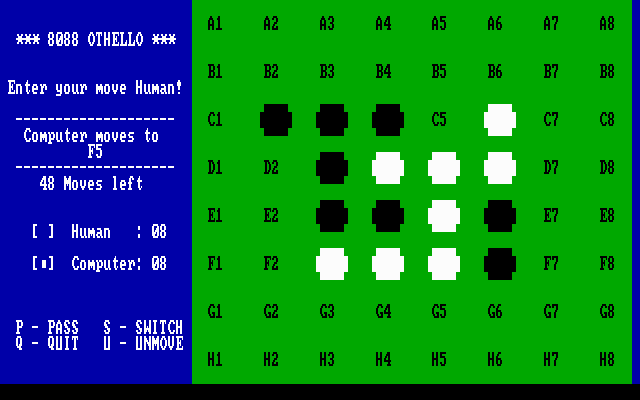Retro Replay Review
Gameplay
8088 Othello centers on the classic mechanics of Reversi-style strategy, challenging you to outflank the computer opponent on an 8×8 grid. You exclusively play with the black pieces, striving to flip as many of the white pieces as possible by sandwiching them vertically, horizontally, or diagonally. The simplicity of the rules belies a deep strategic system that rewards foresight and pattern recognition.
(HEY YOU!! We hope you enjoy! We try not to run ads. So basically, this is a very expensive hobby running this site. Please consider joining us for updates, forums, and more. Network w/ us to make some cash or friends while retro gaming, and you can win some free retro games for posting. Okay, carry on 👍)
The game employs a coordinate-based input method: you type in the grid position (for example, “D5”) to place your piece, and the ASCII-rendered board updates in real time. This approach may feel unfamiliar at first, but it allows for precision once you get comfortable with the letter-and-number pairing on the margins of the board. If you ever make a misstep, the “unmove” option lets you retract your last turn, giving you a chance to rethink your tactics.
With five difficulty levels ranging from 1 (easiest) to 5 (hardest), 8088 Othello caters to novices and seasoned players alike. Lower levels serve as a gentle introduction, while the top tiers deliver a formidable AI that can trap your pieces in corners and edges with remarkable efficiency. Additionally, the “pass” and “switch” commands at the main menu add tactical layers: you can skip a turn when no favorable move is available or swap sides for a fresh challenge against the same AI logic.
Graphics
The visual presentation in 8088 Othello is entirely rendered in four-color ASCII graphics, recalling the golden age of DOS-era board games. Each square is clearly delineated, and contrasting characters represent black and white discs. While there’s no high-resolution art or animations, the minimalist aesthetic emphasizes function and legibility over flair.
Color coding enhances the readability of the board; black pieces appear in one hue, white pieces in another, and the grid lines and coordinate labels stand out in complementary tones. Though the design may seem dated by modern standards, it carries a nostalgic charm that many retro-gaming enthusiasts will appreciate. The absence of graphical clutter keeps the focus firmly on strategic decision-making.
One quirk of the interface is its dependence on keyboard navigation and text input rather than mouse clicks or touch controls. This approach demands a learning curve but ultimately results in swift, text-driven gameplay that can feel almost tactile—like moving physical tiles on a board. For players seeking a clean, distraction-free environment, the ASCII look-and-feel succeeds admirably.
Story
As a pure abstract strategy title, 8088 Othello does not feature a traditional narrative or characters. Instead, its “story” unfolds move by move on the checkerboard, turning each session into a mini-drama of shifting power and territorial conquest. The absence of lore or cutscenes might disappoint those who crave a storyline, but it also underscores the timeless appeal of tactical confrontation.
Thematically, the game draws on the classic heritage of Othello/Reversi, where the only narrative is the ebb and flow of your own strategic wits against the computer’s algorithmic cunning. Every flip of a piece can feel like a plot twist, and the final count of black versus white discs serves as the ultimate denouement. In this sense, the game’s “story” is self-authored by your choices.
Rather than following a hero’s journey or mission-based progression, 8088 Othello invites you to craft personal stories of come-from-behind victories and narrow defeats. Replayability stems from the variability of each AI encounter and your evolving tactics, giving every match its own narrative arc—if you choose to see it that way.
Overall Experience
8088 Othello stands out as a compelling homage to classic board gaming on the PC, merging straightforward ASCII visuals with deep strategic gameplay. Its coordinate-input system and limited command set (pass, switch, unmove, quit) may seem austere, but they deliver a streamlined experience that keeps every match moving at a steady pace. The lack of high-score tracking is a curious omission, yet it reinforces the idea that every game is its own self-contained contest.
The five-tier difficulty system ensures that both newcomers and veterans find ample challenge, and the ability to unmove your last turn adds a forgiving touch for experimental play. While modern gamers accustomed to flashy graphics and narrative campaigns might find the presentation bare-bones, those who appreciate pure strategy will discover a satisfying mental workout in every session.
Ultimately, 8088 Othello is best suited for players who enjoy abstract puzzles and value cerebral competition over spectacle. The nostalgic ASCII art, responsive AI, and clean interface come together to create an experience that feels both rich in tactical depth and refreshingly unencumbered by extraneous features. If you’re seeking a no-frills board game challenge that tests your ability to control space and anticipate your opponent’s moves, this title delivers exactly that.
 Retro Replay Retro Replay gaming reviews, news, emulation, geek stuff and more!
Retro Replay Retro Replay gaming reviews, news, emulation, geek stuff and more!







Reviews
There are no reviews yet.